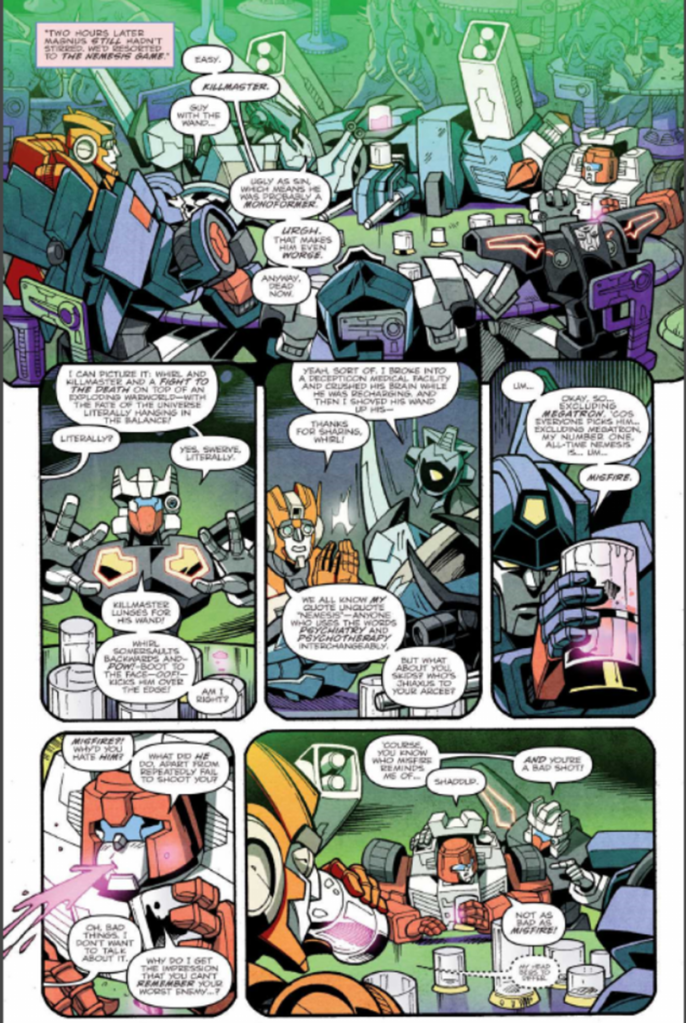In a way, James Roberts’ run on Transformers comics is very gay.
Which makes sense. After all, Cybertronians are adults, have human-like personalities and generally use male pronouns. They may use terms like ‘conjunx amica’ and ‘conjunx endura’, but it’s clear that several affectionate pairs form over the course of Roberts’ eighty-plus comics. This can be anything from outright declarations of love to holding hands to simply the way two characters relate to each other. Love is a normal thing in Cybertronian society, so the fact that multiple pairs of male-pronoun-using characters are together goes completely unremarked in the book.
I should note that, prior to this series, I was not a Transformers fan. I’ve completely forgotten any Transformers cartoons I watched when I was young, which means my prior Transformers knowledge is largely through pop culture osmosis. So when I talk about the things I love about Roberts’ Transformers comics, I don’t have a good sense whether these qualities are common across all Transformers media, whether they originated in other TV shows or comics, or are largely unique to Roberts’. For all I know, Transformers media is filled with male-presenting Cybertronians having romantic arcs with each other. (Though going by pop culture osmosis, I suspect not.)
For a bit of context to these comics, let’s step back to 2012. Comics publisher IDW has had the Transformers license for a few years, building up their own continuity of the Autobot-Decepticon war through various series and miniseries. And then the war, which has lasted for four million years, ends. The Autobots win but it’s not a victory anyone feels good about. The planet of Cybertron is a devastated wasteland. Ordinary Cybertronians who avoided signing up to either faction are returning from across the galaxy en masse, and are generally pissed at what all the ex-warmongers have done. Optimus Prime has stepped down from his leadership position and returned to his civilian name of Orion Pax, leaving to wander the galaxy on his own.
Two ongoing comics series emerge from this status quo. Transformers: Robots in Disguise (written by John Barber, primarily drawn by Andrew Griffith) is set on ruined Cybertron and is about the Cybertronians’ attempts to reestablish society and government, with the Autobots quickly discovering that the non-aligned Cybertronians will not allow Bumblebee and his cohort to rule autocratically. I enjoy the first few arcs of this series, particularly Starscream discovering his scheming and speechifying makes him a genuinely effective politician. The poor Autobots find it hard to imagine why putting tracking and explosive chips inside every surrendered Decepticon is not popular with the mass Cybertronian population.
The other series, Transformers: More Than Meets the Eye, is the one written by Roberts. This book is composed of characters who, for one reason or another, aren’t comfortable with settling down in the new Cybertron society. Hot Rod, now renamed Rodimus, elects to leave with four hundred compatriots to search for the mythical Knights of Cybertron. It’s transparent that this is nothing more than an excuse – most of them think the Knights never existed – but it’s a goal to be working towards. And for people who’ve been involved in the Autobot-Decepticon war for four million years and are now feeling a sense of purposelessness, any goal is enough.
It’s a sprawling cast of misfits and their picaresque adventures around the galaxy. And Roberts makes these characters so compelling. From Rodimus’ excitable and self-aggrandizing style of leadership to Ultra Magnus’ supercilious rules enforcement to Tailgate’s woobie-esque naivete to Rewind’s painful and secret quest, there are a lot of personality clashes and character arcs that drive this soap opera. And while this is very much an action series, some of my favorite moments are the quiet times where characters just talk to each other, or sit around chatting at Swerve’s bar.

Did I mention this book is funny? Not all the time; there’s a lot of straight action and sometimes downright horror. But practically every issue has at least one line of dialogue I feel compelled to repeat to whoever’s near me, be it a quip or a character making a choice, or even the absurdity of the plot itself. For example, the following is the opening page of the 2012 annual, where some of the cast have been shrunk down so they can do a Fantastic Voyage plot to go inside Ultra Magnus to destroy the nanocons infesting his jaw:

While they’re successful in cleansing most of the nanobots, there are a few left over, and there’s only one way that the perpetually scowling Ultra Magnus can get rid of them:

This, incidentally, takes place in the first four pages of an annual. It sets up Ultra Magnus’ character and how the rest of the crew feel about him (you can imagine how much he enjoys all the smiling jokes the crew makes afterwards) and lays the ground for a small character arc when, as the Lost Light crew meet a cadre of alien diplomats, he is tempted to leave the crew and enforce the law in a place that would offer him more respect. The presence of the nanocons foreshadows their appearance in a later story, and even Ultra Magnus’ capacity to smile comes back. And this isn’t even the main plot of the issue! The meat of it is arriving at Drift’s home city and exploring a metrotitan that has links to the Knights of Cybertron, as well as Swerve having a heart-to-heart with a dying Cybertronian from a previous story-arc…
Roberts’ plotting is dense. More than that, it’s intricate. It gives a sense that practically everything in the series was plotted from the outset and deftly foreshadowed. Even insignificant things like striking a Cybertronian in a certain place to trigger an involuntary transformation, which comes up in an early comedic story of how to sneak a passed-out Ultra Magnus back from a planetside bar, is a key part of the penultimate issue’s climax.
If I have a problem with these comics, it’s their density. Maybe it’s easier for a Transformers fan who knows a lot of these characters already, but for a novice there are a lot of fairly similar faces, throwaway character detail and plot mechanics to keep track of. For the first few volumes I found myself paging back to the character headshots and bios a lot.
But that, strangely enough, is also part of this series’ appeal for me. I’ve now read the early parts of the story three times, but this is the first time I’ve read all eighty-odd issues of Roberts’ run. I’m writing this the day I read the final issue, and already I want to go back and read from the beginning. There are so many revelations and twists based on things that I’m sure I’ve seen in earlier issues, but I don’t know them well enough to recall them fully.
And that might be the secret to one of the appeals of this series. Sure, any literary puzzle-box is interesting to dissect and see how it all fits together, encouraging rereading once you know the solution. So its puzzle-box nature is a perfect excuse to revisit these characters again, laugh at all the jokes and watch their soap opera arcs slowly unfold again. To reread not only allows me to enjoy the same comics I’ve enjoyed before, but to more deeply appreciate the intricate Chekovian foreshadowing of it all.
I also love the worldbuilding. Sure, there’s some jokes – the two major psychiatrists we meet are Rung and Froid – but the medical issues surrounding a Cybertronian’s transformation cog, or the cultural importance of donations of innermost energon, all serve to differentiate the characters from being merely funny-looking humans. And the flashbacks to early history is fascinating. I’m not sure how much of this is in other Transformers media, but I love that idea that the Decepticon movement was originally right. It was formed to oppose an increasingly functionist ideology, where the government was restricting Cybertronians to career paths based on their alt mode regardless of their interests. And later, since there is a finite numbers of sparks that give Cybertronians life, the government began to execute non-useful alt-moded Cybertronians to harvest their sparks for implantation into more productive bodies.
In this context Megatron is very much a heroic figure. Initially an obscure miner on the moon of Tarn, writing and distributing poetry in secret, he writes a profoundly influential manifesto that helps coalesce dissidents into the Deception movement. It is only after the war is in full swing that Megatron loses track of the political goals he was fighting for and focuses only on increasingly brutal warfare, transforming him into the archetypal villain of the Transformers franchise. So naturally he is not happy in these comics when he returns to find the war is over; and, gallingly, that Starscream is a more effective leader of Cybertron than he could be. Megatron’s subsequent character arc across the series is one of my favorite aspects of the book.
I must also mention the art. After all, the wonderful character stuff I’ve been raving about wouldn’t amount to a hill of beans if the art couldn’t communicate that character. And think about most Transformers’ bodies. They’re not designed for subtle gestures or body language. Half of them don’t have visible mouths! That’s what makes these artists so astonishing, that they can sell so much character through such limited and non-human forms. Unfortunately I don’t really have the toolbox to diagnose how these artists do what they do. All I can do is point to the pages – particularly from Alex Milne, who drew the most issues in the series – and say, “Yep, that captures Tailgate’s personality exactly.”

Given how much I love this series, I do want to read more Transformers comics. At some point I’ll try the Simon Furman UK Transformers, as that run is a huge touchstone for British comics creators of a certain age. But I’m not sure anything else is going to feel quite right. After all, Roberts’ run is the one I’m most invested in, and it’s now my definitive view of what Transformers stories can be. For me, the real Transformers franchise is set after the war’s ended, starring a bunch of Autobots and Decepticons looking sheepishly at each other, trying to figure out what to do next.

Where to find it: Broadly, James Roberts scripted two runs:
–Transformers: More than Meets the Eye (2012-2016) #1-57
–Transformers: Lost Light (2017-2018) #1-25
There are also a few annuals, one-shots and other things.
Also a shout-out to the House to Astonish podcast. Without them I’d never have known about this series.

